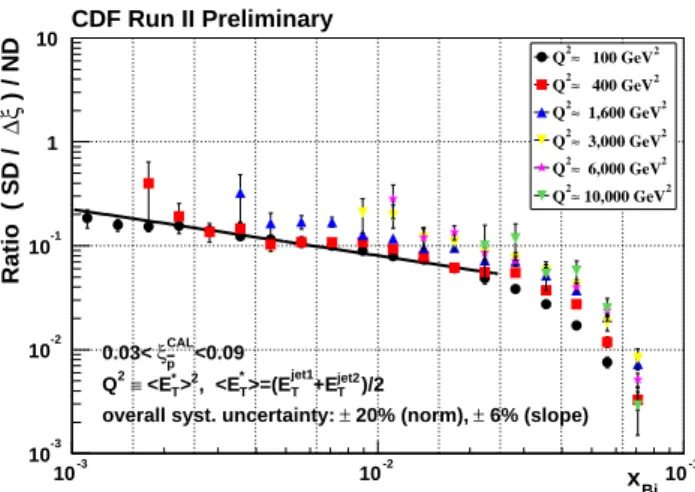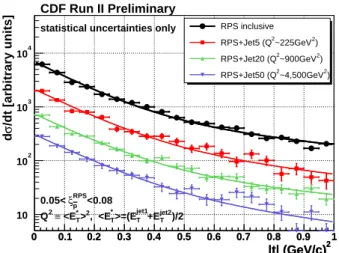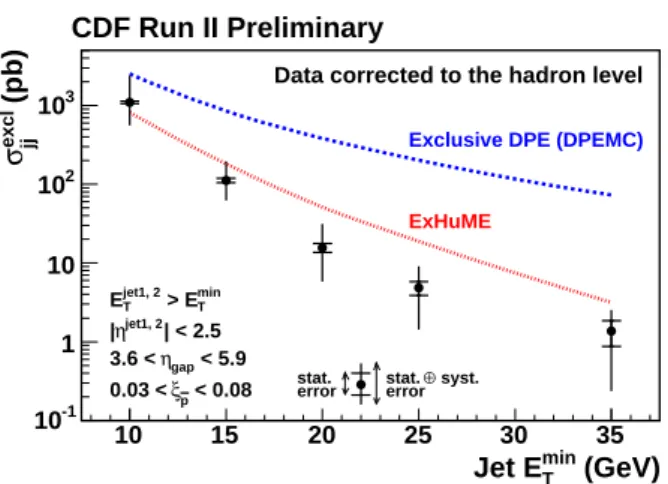804 Brazilian Journal of Physics, vol. 37, no. 2C, June, 2007
New CDF Results on Diffraction.
Christina Mesropian1, on behalf of the CDF Collaboration
1The Rockefeller University
1230 York Avenue New York, NY 10021, USA
Received on 2 November, 2006; revised version received on 23 March, 2007
We report new diffraction results obtained by the CDF collaboration in proton-antiproton collisions at the Fermilab Tevatron collider at√s=1.96 TeV. The first experimental evidence of exclusive dijet and diphoton production is presented. The exclusive results are discussed in context of the exclusive Higgs production at LHC. We also present the measurement of theQ2andtdependence of the diffractive structure function.
Keywords: QCD; Diffraction; Exclusive production
I. INTRODUCTION
Diffractive reactions, which constitute a substantial frac-tion of the total cross secfrac-tion in hadron-hadron scattering, can be described in terms of thepomeronexchange, hypothetical object with the quantum numbers of the vacuum. The ex-perimental signatures of the diffraction consist in particular kinematic configurations of the final states: presence of non-exponentially suppressed large rapidity gaps and/or presence of the intact leading particles. The diffractive processes be-came an important tool in understanding many interesting as-pects of QCD such as low-xstructure of the proton, behavior of QCD in the high density regime. Recently, a lot of atten-tion was drawn to the possibility of discovering diffractively produced Higgs boson at the Large Hadron Collider (LHC).
Significant progress in understanding diffraction has been made at the Tevatron pp¯ collider. CDF collaboration con-tributed extensively by studying wide variety of diffractive processes at three different center-of-mass energies:√s=630 GeV, 1800 GeV - Run I of Tevatron, and 1960 GeV - Run II. Many important observations were made regarding the dif-fractive structure function of thepomeron, the breakdown of QCD factorization in hard diffraction between Tevatron and HERA, and the discovery of large rapidity gaps between two jets [1-3].
II. DIFFRACTIVE DIJET PRODUCTION
One of the diffractive processes studied during Run I and Run II is the hard single diffraction, which from the phe-nomenological point of view is described by assuming that a pomeronemitted by the incident antiproton undergoes a hard scattering with the proton. Comparing two samples of dijet events, diffractive, triggered by the presence of intact antipro-ton, detected in the Roman Pot Spectrometer (RPS), and non-diffractive, the diffractive structure function can be extracted. We extended our results from Run I by examining theQ2 de-pendence of the structure function, whereQ2is defined as an average value of the mean dijetET. Fig. 1 shows the ratio of
single diffractive dijet event rate to those of non-diffractive, RSDND, as a function ofxB j. In the range of 100<Q2<10000
GeV2no significantQ2dependence is observed.
Bj
x
) / ND
ξ∆
Ratio ( SD /
10-3 10-2 10-1 1 10
/ ndf
2
χ 23.26 / 12 Prob 0.0256 Const 0.01031 ± 0.0009656 slope 1.027 ± 0.04422
/ ndf
2
χ 23.26 / 12 Prob 0.0256 Const 0.01031 ± 0.0009656 slope 1.027 ± 0.04422
10-3 10-2 10-1
6% (slope)
±
20% (norm),
±
overall syst. uncertainty: )/2
jet2 T
+E
jet1 T
>=(E
* T
, <E
2
>
* T
<E
≡ 2
Q
<0.09
p CAL ξ
0.03<
CDF Run II Preliminary
2 100 GeV ≈ 2 Q
2 400 GeV ≈ 2 Q
2 1,600 GeV ≈ 2 Q
2 3,000 GeV ≈ 2 Q
2 6,000 GeV ≈ 2 Q
2 10,000 GeV ≈ 2 Q
FIG. 1: Ratio of SD to ND event rates as a function ofxB jfor differ-entQ2ranges. Data sample of 128 pb−1.
CDF also studied theQ2dependence oft, four-momentum transfer squared, distributions in both soft and hard single dif-fractive processes. Fig. 2 showstdistributions for differentQ2 values in the range 0<|t|<1 (GeV/c)2. The slope of the dis-tributions at|t|=0 (GeV/c)2does not show any dependence onQ2.
III. EXCLUSIVE DIJET PRODUCTION
Christina Mesropian 805
2
|t| (GeV/c)
0 0.1 0.2 0.3 0.4 0.5 0.6 0.7 0.8 0.9 1
2
|t| (GeV/c)
0 0.1 0.2 0.3 0.4 0.5 0.6 0.7 0.8 0.9 1
/dt [arbitrary units]
σ
d
10 102 103 104
RPS inclusive )
2
~225GeV
2
RPS+Jet5 (Q
)
2
~900GeV
2
RPS+Jet20 (Q
)
2
~4,500GeV
2
RPS+Jet50 (Q
)/2
jet2 T
+E
jet1 T
>=(E
* T
, <E
2
>
* T
<E
≡ 2
Q
<0.08
p RPS ξ
0.05<
CDF Run II Preliminary
statistical uncertainties only
FIG. 2: tdistributions in soft and hard SD events for differentQ2
ranges.
at the Tevatron, several processes mediated by the same mech-anism but with higher production rates can be studied to cal-ibrate theoretical predictions. In this proceedings we present results of exclusive dijet production in hadron colliders.
The characteristic signature of this process is presence of intact leading nucleons with exclusive dijet final state. At CDF the leading antiproton is detected by RPS, and the pres-ence of leading proton is inferred from the large forward rapidity gap with ∆η<3. The observable, sensitive to the amount of event energy concentrated in dijet isRj j, the dijet
mass fraction, defined as the invariant mass of the two highest ETjets,Mj j, divided by the massMXof the whole system with
the exception of the leading particles.Rj jof exclusive dijet is
expected to be peaked aroundRj j∼0.8 and have a long tail
towards low value due to the hadronization of partons causing energy spills from the jet cones and gluon radiation in initial and final states.
X
/ M
jj
= M
jj
R
0 0.2 0.4 0.6 0.8 1
dN / N
10-4 10-3 10-2 10-1
DPE data (stat. only) POMWIG : H1-fit2 Background
POMWIG + Background
H1-fit2
CDF Run II Preliminary
FIG. 3: Rj jdistribution for data (dark points) and MC predictions (thick solid line) composed of DPE dijet events (thin line) and non-DPE background (dashed line).The data and MC results are normal-ized to the same area.
The search for the exclusive dijets is performed by
compar-ing 310 pb−1of data with Monte Carlo, MC, expectations. We use POMWIG [4] MC event generator with detector simula-tion to obtain DPE dijets, see Fig. 3 which shows a compari-son of the shape ofRj jfor data and MC results, composed of
DPE dijet events and non-DPE background. The evaluation of different Pomeron PDFs and underlying events (Pomeron remnants) in MC showed that these variations cannot account for the excess observed in data at high Rj j . Two
differ-ent exclusive dijet production models [5, 6] implemdiffer-ented in ExHuME [7] and DPEMC [8] MC simulations have been also studied. Fig. 4 shows the Rj j distribution for the data
and the best fit to the data shape obtained from the inclusive POMWIG and exclusive ExHuME predictions in events with dijetET>10 GeV and a veto on third jet. As can be seen from
this plot, the data excess at highRj jcan be well described by
the exclusive dijet production. The exclusive MC DPEMC, not shown here, also provides a good agreement with data.
X / M jj = M jj R
0 0.2 0.4 0.6 0.8 1
Events
0 100 200 300 400 500
CDF Run II Preliminary
DPE data (stat. only) H1
⊕
POMWIG: CDF ExHuME
POMWIG + ExHuME
| < 5.9
gap
η
3.6 < | > 10 GeV
jet2 T
E
< 5 GeV
jet3 T
E
< -0.5
jet1(2)
η = 20.8 ± 0.8 %
excl
F
(stat. only)
FIG. 4: Dijet mass fractionRj jin DPE data (dark points) and best fit (solid line) obtained using inclusive (dashed line) and exclusive ExHuME (shaded line) MC predictions.
One of the crucial advantages of exclusive central produc-tion is the suppression at the leading order of the background sub-processgg→qq¯, asm2/M→0 (Jz=0 selection rule). This
condition is satisfied when the quarks are light or when the dijet mass is much larger than the quark mass. Theqq¯ sup-pression mechanism can be used to extract exclusive dijets by identifying jets originating from quarks and looking for the suppression of quark jets relative to all jets at highRj j. CDF
has performed this study by using 200 pb−1of data triggered by the presence of anti-proton in RPS, forward gap on pro-ton side, dijets in the central region and at least one displaced vertex track with pT >2 GeV/c.The last requirement
effec-tively enhances the heavy flavor content of the sample. Fig. 5 shows the normalized ratio of heavy flavor jets to all jets as a function ofRj j of DPE b-jet events. The decreasing trend
of the normalized ratio towards highRj j could indicate the
suppression of heavy flavor jets in the exclusive signal region. The observed behavior of heavy flavor jet production relative to the inclusive jets is consistent with the results of exclusive dijet signal search in inclusive DPE data sample.
806 Brazilian Journal of Physics, vol. 37, no. 2C, June, 2007
the fraction of exclusive events and by accounting for accep-tances. Fig. 6 shows the exclusive cross section obtained from the data sample compared with predictions from two Monte Carlo simulations, ExHuME and DPEMC. The data clearly favors the ExHuME.
X /M jj = M jj R
0 0.1 0.2 0.3 0.4 0.5 0.6 0.7 0.8 0.9 1
〉
<0.4)jj
(R
bc/incl
F
〈
/
bc/incl
F 0.5 1 1.5
CDF Run II Preliminary
DPE data (SVT)
Systematic Uncertainty
(RAW) > 10 GeV jet
T E
| < 1.5 jet η
|
FIG. 5: Ratio of heavy flavor jets to inclusive jets withET >10 GeV and |η|<1.5 as a function ofRj j. The ratio is divided by the weighted average of the ratio in the rangeRj j<0.4. The shaded band shows systematic uncertainty on the ratio.
(GeV) min T Jet E
10 15 20 25 30 35
(pb)
exclσ jj
-1
10 1 10
2
10
3
10
CDF Run II Preliminary
Data corrected to the hadron level
ExHuME
Exclusive DPE (DPEMC)
min T
> E
jet1, 2 T
E
| < 2.5
jet1, 2 η
|
< 5.9
gap η
3.6 <
< 0.08
p ξ
0.03 < stat.error stat. error⊕ syst.
FIG. 6: Exclusive dijet cross section measured from the data as a function of minimum second jetET. The dashed (dotted) lines shows the ExHuME (DPEMC) Monte Carlo predictions.
IV. EXCLUSIVE DIPHOTON PRODUCTION
Another process which is closely related to exclusive Higgs production is exclusive diphoton productionpp¯→pγγp¯. CDF has performed search for exclusive γγ using data obtained with the trigger requiring presence of two electromagnetic (EM) towers and forward gaps in both forward directions. 16 events containing two electron candidates are found after re-quiring all calorimeters to be empty, except for two trigger EM towers with ET >5 GeV.The observed events are consistent
with QED-mediated dielectron productionpp¯→p+e+ e−+p¯ through two photon exchange. In the same dataset 3 candidate events are found, by requiring all calorimeters to be empty, and no tracks to be associated with two EM trigger towers. The exclusive production estimates [5], implemented in Ex-HuME Monte Carlo generator predict 1+−31exclusiveγγevents. The background estimates are still in process.
V. CONCLUSIONS
CDF experiment continues carrying strong program on dif-fractive physics during Run II. The studies of difdif-fractive struc-ture functions were extended by measuringQ2dependence in the wide range of the values from 100 to 10000 GeV2. The t distribution dependence onQ2 was also presented. New results on exclusive dijet production demonstrate an excess of data events over backgrounds obtained from Monte Carlo predictions and are consistent with predictions from exclusive dijet production Monte Carlo simulations. The results from the exclusive dijet and diphoton production are an important calibration tools for theoretical models describing diffractive Higgs production at LHC.
Acknowledgments
I would like to thank the organizers of XXXVI International Symposium on Multiparticle Dynamics for a kind invitation, warm hospitality, and for an exciting conference.
[1] D. Acostaet al., Phys. Rev. Lett.88, 151802-1 (2002). [2] T. Affolderet al., Phys. Rev. Lett.84, 5043 (2000). [3] F. Abeet al., Phys. Rev. Lett.74, 855 (1995).
[4] B.E. Cox and J.R. Forshaw, Comput.Phys.Commun.144, 104 (2002).
[5] V.A. Khoze, A.D. Martin, and M.G. Ryskin, Eur. Phys. J. C21, 311 (2002); Eur. Phys. J. C26, 229 (2002); Eur. Phys. J. C34,
327 (2004).
[6] A. Bialas and P.V. Landshoff, Phys. Lett. B256, 540 (1991). [7] J. Monk and A. Pilkington, hep-ph0502077.


